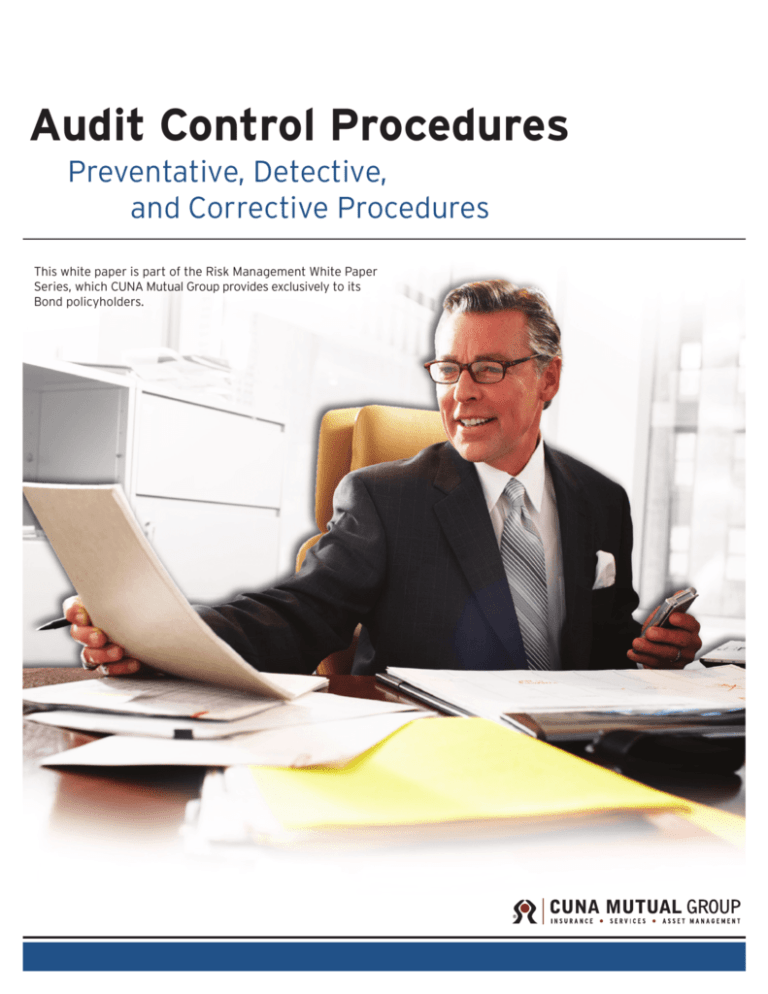
Audit Control Procedures
Preventative, Detective,
and Corrective Procedures
This white paper is part of the Risk Management White Paper
Series, which CUNA Mutual Group provides exclusively to its
Bond policyholders.
TABLE OF CONTENTS
Table of Contents
Introduction to Audit Control Procedures ................................................................. 2
Cash Counts....................................................................................................................... 2
Loans................................................................................................................................... 3
Overdrawn Accounts....................................................................................................... 5
Employee and Family Member Account Review....................................................... 6
Dormat Accounts ............................................................................................................. 6
Closed Accounts ............................................................................................................... 6
Audio Response/Home Banking ................................................................................... 6
Bank Reconciliations ....................................................................................................... 7
Fedline Parameters.......................................................................................................... 7
CUNA Mutual Group y Audit Control Procedures y Mar 2010
1
INTRODUCTION
Introduction to Audit Control Procedures
Credit union operations should be periodically reviewed by people who are
independent of these operations.
There are three types of control: preventive, detective, and corrective. Internal
controls are part of the preventive control. They are designed to foresee and
avert problems. Audit control procedures are part of the detective control.
They are designed to see if the preventive controls are working. Revising
policies and procedures when a weakness is discovered is part of the corrective
control. They are designed to strengthen the internal control process.
The purpose of these audit control procedures is to supplement, not replace,
the yearly supervisory audit required by credit union regulators.
Cash Counts
Cash counts are an important part of internal control procedures. Periodic cash
counts encourage honesty and discourage embezzlement. Cash counts should
be conducted on a surprise basis by someone independent of the cash
operation (management, internal audit, supervisory committee, etc).
All cash items, including travelers’ checks, movie tickets, etc. should be part of
the cash count. You do not have to count every teller drawer and the change
fund all at once. Instead, you may wish to count the change fund one day, the
travelers’ checks another day, and several teller funds another day. ATMs and
cash dispensers should also be included. The cash counts should be frequent
enough to deter dishonesty, or detect dishonesty if it is occurring.
Conduct the cash count in the presence of the employee responsible for
maintaining the funds. If there is a shortage, the individual responsible cannot
accuse the person performing the cash count of removing funds. In the event
that employee responsible for the funds is absent, the key or combination to
the container should be retrieved and the cash should be counted under dual
control.
Verify cash count totals with the general ledger accounts to determine
accuracy.
CUNA Mutual Group y Audit Control Procedures y Mar 2010
2
CASH COUNTS
The key points to remember about cash counts are:
•
Cash counts should be a surprise
•
Cash counts should be conducted frequently
•
The individual responsible should be present
•
Cash totals should be verified
Loans
Loans are the credit union's largest asset, meaning several areas need to be
monitored.
Fictitious/unauthorized loans are a common technique used by the embezzler.
Select a sample of loans approved by each loan officer and the credit
committee for review. The selection process should include cash payment
loans, not loans on payroll deduction. Make sure all the necessary documents
are completed. Contact the borrower by telephone to confirm he/she is a real
person and the loan proceeds were received. This verification can be done as a
customer service inquiry. Refer to "Credit Union Audit Procedure: Detection of
Fictitious/Unauthorized Loans" (0281-205) for additional information on
conducting this procedure.
Another area to review is the member account trial balance. Review loans with
the following indicators to determine their validity:
•
Paid ahead due date of more than three months
•
High amount of interest due, but the loan is current
•
Original loan amount and current loan amount are the same, but the
loan is not listed on the delinquency report
A copy of the member's history along with the loan documents can pinpoint any
account manipulation. Direct telephone contact with the member may be
required.
Employee and family member loans are an easy way for a dishonest employee
to obtain funds. Analyze all employee and family member accounts. This review
can be done with the overdrawn account review.
CUNA Mutual Group y Audit Control Procedures y Mar 2010
3
LOANS
The account review should confirm the following:
•
Employees are not performing transactions on their own or family
member accounts
•
Interest rates are correct
•
Loan payments are made in the proper amount and at the required
frequency
•
Collateral requirements are met and the proper documentation is
available
•
Loan approval is not exceeded as stated by loan policy
Official and family member loans can be used as a means to receive
preferential treatment. Officials, by nature of their position, can put undue
pressure on credit union personnel to circumvent the loan policy for their own
needs. Review these loans to ensure board-approved policies are followed.
Delinquent/charged off loans should be verified to assure proper collection
procedures are being followed. Look at the loan files for indicators of fictitious
loans. If collateral exists, has it been repossessed and sold? If a co-maker is
involved, has he/she been contacted to begin payments? Are
delinquent/charged-off loans reported to the board of directors and recorded in
the board minutes? Is all collection activity documented? Are progressive
collection efforts being followed?
Co-maker forgery is a potential source of loss for the credit union. Authorized
credit union personnel should witness co-maker signatures. If the co-maker is
unable to come to the office to sign the documents, a notary public should
witness the signature.
The file maintenance report shows any data changes made in the computer
system. Data changes can be used to manipulate loan accounts.
Review this report to include the following types of transactions:
•
Advancing payment due dates
•
Changing interest rates on any account
•
Changing the payment amount
•
Several address changes to the same address
•
Changing the payment frequency
•
Changing the collateral code
CUNA Mutual Group y Audit Control Procedures y Mar 2010
4
LOANS
The key points to remember regarding loan reviews are:
•
Contact members to confirm loans
•
Prohibit employees from performing transactions on their own or
family member accounts
•
No one should receive preferential treatment
•
Verify delinquent/charged off loans for policy compliance
•
Credit union personnel or a notary public should witness co-maker
signatures
•
Review file maintenance reports on a regular basis to ensure loan
manipulation is not occurring
Overdrawn Accounts
An overdrawn account is the use of credit union funds without paying interest,
or an interest-free loan.
Employee, official, and family member account histories/transactions should be
reviewed. Determine if an overdrawn status exists either in the share or share
draft account. Review the daily share draft exception report for a 30 day
period. Are any employees, officials, or family members listed on the report?
Are the share drafts being paid?
Members should not be permitted to overdraw their accounts. The credit union
should have an overdrawn account policy in writing. The policy should include a
method for dealing with abusers. A review of a computer generated overdrawn
share and share draft accounts report will show accounts with a negative
balance. Some computer systems will not allow an account to have a negative
balance. The overdrawn share drafts are put in a general ledger share draft
suspense account. Review the subsidiary account for this suspense account to
determine if overdrawn share drafts are being paid or if items are allowed to
remain in this account. If the share drafts are not being paid or returned, you
must find out why. Members who are allowed to remain in an overdraft status
might be kiting. This could lead to a loss for the credit union.
The key points to remember about reviewing overdrawn accounts are:
•
Write and enforce an overdraft policy
•
Review insider transactions for overdrawn accounts
CUNA Mutual Group y Audit Control Procedures y Mar 2010
5
OVERDRAWN ACCOUNTS
•
Review the daily share draft exception report for a 30 day period to
identify abusers
•
Review the subsidiary account for the share draft suspense account to
determine if items are being paid or returned
Employee and Family Member Account Review
Periodically, a review of employee and family member accounts should be done
to test for policy compliance. Employees should not be performing transactions
on their own or family member accounts. Review unusual transactions, large
deposits and frequency of deposits made to cover items being presented for
payment. If the data processor provides you with a report of failed log on
attempts, this report should be reviewed on a regular basis.
Dormant Accounts
Dormant accounts are frequently used to perform unauthorized transactions.
Establish procedures to verify transactions. If a dormant account activity report
is not available, contact the data processor to find out if the system can
generate one. Review this report and consider requiring a supervisory override
to conduct a transaction on a dormant account. A verification of withdrawals
from dormant accounts should be made. The canceled share draft compared
with the member's signature card is one form of verification. Direct contact
with the member is another form of verification.
Closed Accounts
Closed accounts should also be used by the embezzler. Review the closed
account report on a regular basis. Choose a selected sample of closed accounts
and compare the canceled share draft/check endorsement with the signature
on the membership card to protect against forgery.
Audio Response/Home Banking
Cross account transfers (those going from one member's account to another
member's account) should be audited periodically to test for legitimacy. Cross-
CUNA Mutual Group y Audit Control Procedures y Mar 2010
6
BANK RECONCILIATIONS
account transfers should require the signatures of both account holders and
only a limited number of employees should have the ability to set up these
accounts.
Bank Reconciliations
The bank reconciliation of the credit union's checking account can be used to
conceal a shortage. Review the bank reconciliations to ensure deposits in
transit are posted on the next month's bank statement in a timely manner. Are
all additions and subtractions to the reconciliation being resolved in a
reasonable amount of time? Returned items appearing on the bank statement
might be a sign of kiting. Trace these items to determine if they are being
immediately re-deposited or deducted from the member's account.
In summary, if a discrepancy exists, inform the board of directors and
management immediately. If the exception involves a manager or board
member, notify the next highest level of authority. The credit union's
supervisory agency and bonding company should also be put on notice of a
potential bond claim.
Evaluate the weakness in the internal control process which allowed the
discrepancy to occur. Take corrective action to make sure it cannot happen
again.
Fedline Parameters
Periodically request the end user authorization contact (EUAC) to print out the
Fedline parameters to verify they are properly set. This should be done as soon
as it is requested while in the presence of the person requesting the
parameters.
Contact CUNA Mutual Group
For additional assistance, contact the Credit Union Protection Response Center
at 1.800.637.2676. You can also e-mail us at cuprotection@cunamutual.com or
visit the Protection Resource Center at www.cunamutual.com/prc.
CUNA Mutual Group y Audit Control Procedures y Mar 2010
7
CUNA Mutual Group is a leading provider
of financial services to credit unions,
their members, and valued customers
worldwide. With more than 70 years of
market commitment, CUNA Mutual’s vision
is unwavering: to be a trusted business
partner who delivers service excellence
with customer-focused, best-in-class
products and market-driven innovation.
Visit www.cunamutual.com or call
800.356.2644 for more information.
CUNA Mutual Group Proprietary and Confidential. Further Reproduction, Adaptation, or Distribution Prohibited.
Insurance products offered to credit unions are underwritten by CUMIS Insurance Society, Inc., a member of the CUNA Mutual Group. CUNA Mutual
Insurance Agency, Inc., an affiliate within CUNA Mutual Group, is the marketing agent licensed to broker Property and Casualty coverages.
10001459-0310 © CUNA Mutual Group, 2010 All Rights Reserved.
P.O. Box 391
5910 Mineral Point Road
Madison, WI 53701-0391
800.356.2644
www.cunamutual.com








